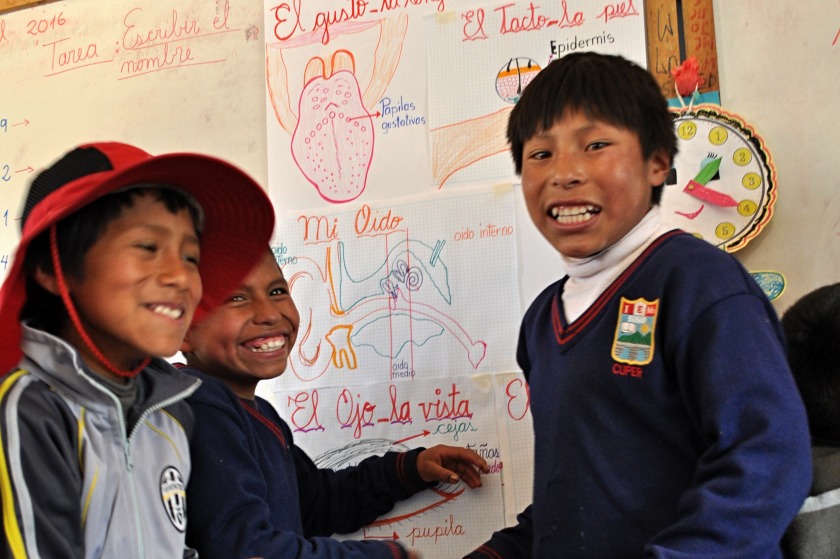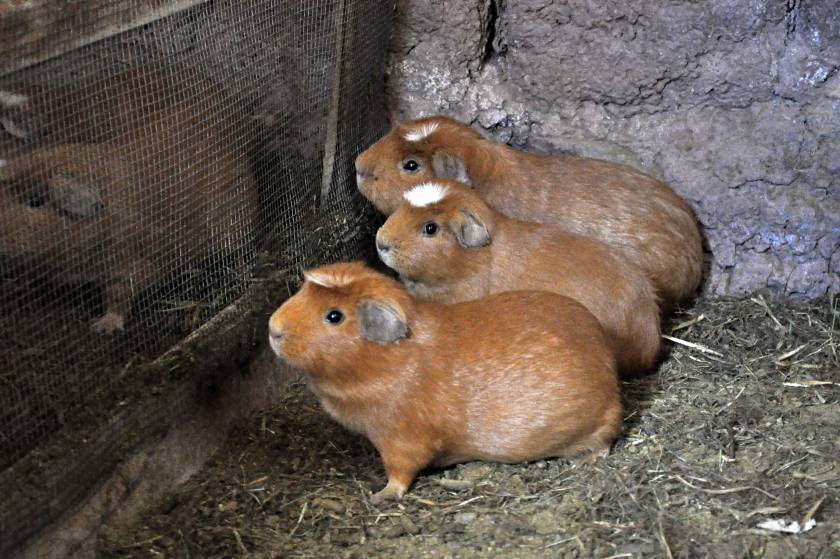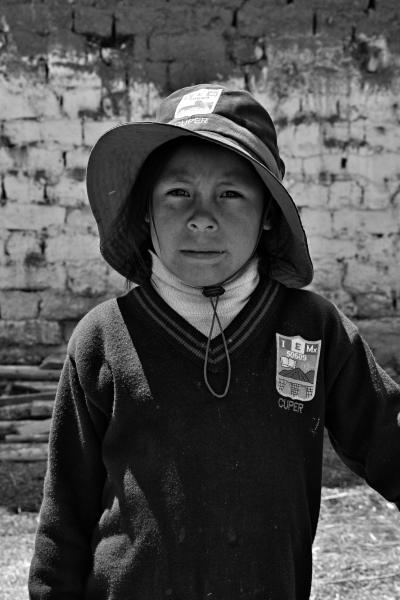The small boy, who couldn’t have been more than 5 or 6 years old, bravely stepped up and took my hand as I descended the steps of the bus. He then led me off to discover his world.
We left Lima that morning, en route to the highlands of Peru. There are two options for making that trip, a 20-25 hour slog up the mountains via highway, or the quick, pricier way, a 90-minute flight via commercial jet to Cuzco. As we had limited time our group took the flight.
But we weren’t bound for Cuzco that day, our ultimate goal was Urubamba and the Sacred Valley. On the way, we had a couple stops in the town of Chinchero.
The first was at Cuper primary school. It’s an interesting choice for a touring company to make, and at first I had my doubts. What possible connection could there be between an older, childless, American guy and his ilk, all well off enough to go gallivanting around the world, and a bunch of young, poor Peruvian kids? I can barely even relate to American kids as I’m so rarely around any. Turns out, it was a good choice on a number of levels.
When my young guide took me by the hand and led me towards the school gate, I had no idea what to expect. I’m not sure he did either, but he seemed to have a young, trusting innocence that all would be well.
I used much of my Spanish vocabulary to break the ice. “Como se llama? ” – what is your name?
“Wilson”, he replied. That surprised me. I was expecting something more Spanish, or Andean. What I got gave me a flashback to a humanized volleyball, Tom Hank’s imaginary friend in the movie Castaway. I said “me llamo David“, and we moved on.
Our guide gathered up all the kids and travelers in the schoolyard and gave us his spiel. He talked about how hard it was for kids to get ahead, to get an education, to escape the grind and cycle of poverty so common in the Andes. He mentioned that was a reason the tour company sponsored various schools and helped them build up their infrastructure. The kids and teachers then sang us a couple songs in Quechua, the primary language for the locals. As the kids got older, they’d learn more Spanish. The formalities broke up, and the children showed the adults their world.
I hooked up with a new set of boys, older this time, who took me to their classroom.

They seemed a joyful lot, full of grins, laughter, and vigor. I didn’t know if their enthusiasm was to show off what they were learning, or if they were just happy to have a bunch of foreigners break up their studies with play. Whatever the case, their friendliness and friendship were obvious.
 |
 |
After leaving the schoolhouse they took me by the hand and led me towards an outbuilding. I was apprehensive when they opened the doors to a low-ceilinged dark room and pulled me in. A blast of ammonia assaulted my nose, and as my eyes adjusted to the light I could see the source.

Cute little buggers, eh? I thought perhaps it was a class project, bring up some animals and learn about the process.
Turns out guinea pigs are considered a delicacy in Peru. That cute little class project was fated to end up on a dinner plate.
The fun and games continued. The kids broke out frisbees and soccer balls and impromptu sessions broke out, testing our mobility and reminding us that Chinchero is at 12,400 feet (3,800 meters), and the air is about as rich as the people. Ancient frisbee skills from my own childhood days came in handy.

My lesson was complete. A weakness of many guided tours is they turn you into mere tourists – you never really meet the people. This one, at least for a moment, turned that on its head and we had a small taste of day to day. And it turned out that even a crusty old goat like me can be touched by a bunch of sweet, innocent little kids.


What a wonderful way to meet the people of Peru. I usually feel a little awkward around kids too, but it’s usually worth taking the chance. They have such an interesting way of seeing the world, free from gunked-up lenses. 😉
LikeLiked by 1 person
First world kids have so much at their fingertips, so fast, that it seems like their lens get gunked-up faster. These kids still seemed to have an unspoiled joy. Of course it’s hard to get more than just a general sense in the time we had, maybe they have their own quirks.
LikeLiked by 3 people
One of the reasons we have travelled as much as we have, and often choose second or third world countries to travel through has been a conscious parenting decision. We wanted our kids to grow up, not just knowing, but experiencing the way other people live and the way other people can experience joy with so much less. We have a photo in our hallway, taken when they were 5 & 7, of them playing soccer with some village kids on a dirt clearing in Taman Nagara, at that time deep in the off-the-beaten path area of Malaysia. It is there as a reminder. It was one of many special moments they experienced over the years. I hope those experiences are woven into the fabric of who they have become, now that they are adults.
LikeLiked by 1 person
I bet you were successful. One of my favorite quotes: “Travel is fatal to prejudice, bigotry, and narrow-mindedness, and many of our people need it sorely on these accounts. Broad, wholesome, charitable views of men and things cannot be acquired by vegetating in one little corner of the earth all one’s lifetime.” – Mark Twain
LikeLiked by 1 person
Nice! I really like that one. It has anger in its tone, but its point is spot on!
LikeLiked by 1 person
Years ago, I found myself watching children play soccer on a street in Mexico. That does not sound unusual but their village was located on a very steep mountainside and one end of the field was a good fifty feet below the other. Every few minutes the sides would switch goals.
Where there is will, children will always find a way.
LikeLiked by 3 people
Wouldn’t it be nice if we could get adults to play nice the way we do with kids?
LikeLiked by 1 person
That reminds me of watching a group of kids in India playing cricket on the side of a mountain. ‘Lost ball’ was a common problem!
LikeLiked by 2 people
Crusty old goats have their soft side too; I liked this story — especially the notion the tour company does that. My wife and I were just ideating similar things this morning, about facilitating more connection-based tours, so that’s funny you wrote about it! I get the Wilson reference too. That was dark and unusual for Tom, I liked it.
LikeLiked by 1 person
Who says you can’t teach an old dog new tricks?
LikeLiked by 1 person
I will be waiting to see if you ate any of that guinea pig! I can’t remember if it was in Chinchero or Ollantaytambo that we were semi-forced to try a bite of that skinned, scorched animal staring at us from a platter, but I did suck it up and take a (very, very small) bite. But to go back to the sweeter side of your post, I’m glad you connected for a short time with those wonderfully sincere kids.
LikeLiked by 1 person
I’ll mention it in the next post, but yes, in Chinchero we had a lunch with a variety of items, one of which was a very small (may 1/2 x 1 inch) bite of guinea pig. That bite was mostly skin and bone, very little meat, and the skin reminded me a bit of the skin from Lechon, a Filipino roasted pig dish.
LikeLiked by 1 person
Quite enjoyed this. Love that you’re open to experiencing things through the eyes of a child. It’s often an enlightening experience. And you’re right, it’s totally an unusual side trip for a tour company to make. Way to go, you “crusty old goat!”
LikeLiked by 1 person
It’s often enlightening to consider something through another’s eyes, even kids. Being childless, I sometimes wonder what perspectives I’ve missed out on.
LikeLiked by 1 person
btw… and feel free to delete this post after you read it… the first phot in this post is only showing up as a question mark, for some reason…
LikeLike
That’s odd. Seems ok on this end. I even tried it on my wife’s laptop to make sure I wasn’t just looking at a cached pic.
LikeLike
What a terrific experience! Traveling is so much better when we have the opportunity to really meet the locals, and children are especially open to sharing who they really are. Sounds like a very smart touring company. Visiting there is good for the kids and school, and also good for the tourists!
LikeLiked by 1 person
Yes, it was fun, and it really was surprising when that tiny little kid just walked up and took me by the hand. Even with the teacher standing by I’m not sure I could ever see that happening in the USA.
LikeLiked by 1 person
There are precious moments of travel that are so unexpected, so out-of-the-way of the big sights and sites, and those golden moments are what makes travel and life so wonderful. Connections that make life a bit more understandable ~ and this post of yours Dave reveals so much. Beautiful writing and beautiful photographs. Th best line, “…even a crusty old goat like me can be touched by a bunch of sweet, innocent little kids.” Amen.
LikeLiked by 1 person
Maybe I’m not that crusty after all…
LikeLike
🙂
LikeLiked by 1 person
It’s good that a number of travel companies do this. It opens the travellers’ eyes to the real people in the countries that they visit.
LikeLiked by 1 person
And even better when the companies help with problems directly. I’ll have another story in this series that was even more eye opening.
LikeLiked by 1 person
Good to hear. I’ll look forward to that.
LikeLiked by 1 person
It must be great to have a visit to a school that didn’t involve homework! It’s pretty cool that the tour company sponsors education. It’s nice to think of people’s visits to the country doing something to help the local community.
LikeLiked by 1 person
Ah, but it did have homework! When I got home I had to write a little essay about it. 😉
I understand being a tour guide is a highly respected profession in Peru. Our guide said he had 5 years of training for it. People know they’re there to not just babysit tourists, but to help them spend their money on the local economy.
LikeLiked by 1 person
That’s great! I really like that way of doing things. I enjoy travel, but I don’t want to do it at the expense of the local people, environment or economy. If things are handled well, it can be a win-win for everyone. 😀
LikeLiked by 1 person
Having missed so many of your posts, I started reading backwards. I must admit, I did feel a little sick, after comparing the cute little pet in the cage with its ultimate fate. Makes me wonder, where do I draw the line when it comes to food. Turns out, its a pretty thin line. 🙂 I truly enjoyed reading this post, Dave. Reminds me of the mountains, where the air is rare, the people don’t have much, and yet, in terms of travel experiences — it’s one of the richest you’d ever get!
LikeLiked by 1 person
Well, they probably don’t regard them as pets, anymore than they would a chicken. At least it’s a useful end. Thanks for reading. ☺
LikeLiked by 1 person